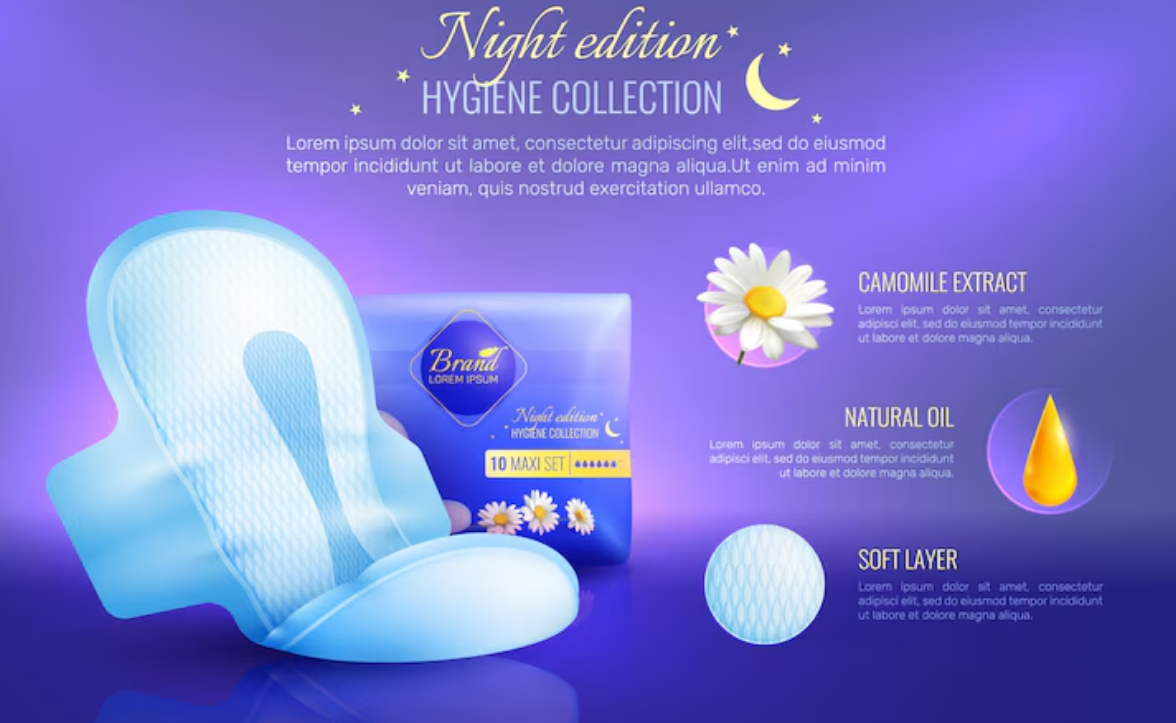For decades, menstrual product ads sanitised periods by showing blue liquid instead of blood. This began in the 1990s when even the word ‘period’ was considered taboo. The blue fluid trick was meant to imply cleanliness, as one journalist notes, blue “evokes cleaning products, like bleach or dishwashing liquid, emphasising a sense of ‘cleanliness’ and hygiene” instead of real blood. NYU law scholar Jennifer Weiss-Wolf says this decades-long approach left menstruation “represented in such a strange, sanitised way.” These ads taught viewers that periods were something to hide, not something normal to see.
Blue-liquid ads became clichés (always followed by a close-up of a spotless pad), but they reinforced the stigma around menstruation. Even tampon and pad testing used dyed saline instead of real blood. In effect, advertising treated uteri and periods as problems to conceal. As Vox reporter Anna North sums up, marketers “began using blue liquid as a workaround in the 1990s” to create a “sanitary atmosphere instead of reminding people about, well, blood.”

Indian brands, too, followed the same template for decades blue liquid became the norm in advertisements from leading sanitary napkin brands. But things are slowly changing. More recent campaigns have begun acknowledging menstrual blood as red, not something to be disguised. HerZindagi traces the evolution of how blood was shown on screen over the years and how long it took for brands to finally embrace honesty and inclusivity in menstrual marketing.
Breaking the Taboo with Red: Global Milestones
That began to change in the 2010s. In 2011, the US brand Always quietly experimented by showing a single red dot on a pad, a small step toward realism. The real breakthrough came in 2017, when UK brand Bodyform (called Libresse elsewhere) released its #BloodNormal campaign. In a bold ad, a red liquid was poured onto a pad and a woman showered with blood droplets on her legs, a scene TV audiences had never seen before. Bodyform’s marketing chief Traci Baxter explained that 74% of people actually wanted more realistic period ads, and vowed, “Together, we can help make blood normal.”
Bodyform’s #BloodNormal campaign (UK, 2017) showed red period blood on a pad, breaking decades of ‘blue liquid’ advertising conventions. The commercial’s tagline was blunt, ‘Periods are normal. Showing them should be too.’ It sent a clear message that silence and shame around menstruation could be challenged.
In the following years, more brands around the world joined in. Bodyform’s ads won praise but also complaints. Similar campaigns in Australia were briefly pulled after public objections to the realistic blood. In January 2020, US brand Kotex became the first major pad maker in America to use red liquid in a TV spot. Online campaigns by smaller brands also spread, biodegradable pad company Carmesi (India) ran a 2018 digital ad with a pad smeared in bright red blood, and Australian toilet spray firm Pee Safe ran a 2019 video showing stained clothing to ‘#OwnTheRed.’ Even tampon startup Floh in India posted images of blood-stained products online in 2019.
View this post on Instagram
Don't Miss:Does Your Period Last Only For Two Days? Expert Says If It's Normal And When to Get Concerned
When Films Went Red: Menstruation in Cinema
Long before advertisements began using red to represent menstrual blood, a few films quietly broke the taboo. In Chokher Bali (2003), a scene shows Aishwarya Rai’s character disposing of a blood-stained menstrual cloth, subtle, yet powerful for Indian cinema at the time. Other films took bolder steps. Phullu (2017) openly showed stained fabric and the harsh reality of period poverty in rural India, while Pad Man (2018) brought mainstream attention to menstrual hygiene, albeit without showing blood. Internationally, Carrie (1976) used menstrual blood as a trigger for horror and trauma, and Pixar’s Turning Red (2022) offered a metaphorical take on puberty and menstruation, including a humorous scene involving pads. These cinematic moments paved the way for more realistic and honest depictions of periods in popular culture—years before the ad industry caught up.

Indian Brands Stepping Up
India’s ad industry has been slower, but change is coming. Traditionally, Indian pad ads also used blue fluid, sometimes even green. A 2020 Times of India report notes that Nobel Hygiene’s Rio Pads launched a pan-India TV campaign showing red blood for the first time. Actress Radhika Apte starred in a Rio spot pouring red drops from a balloon onto a pad, highlighting heavy flow. Apte commented, “Why can’t we show blood? If we can remove even an iota of stigma around periods… then it will be a big win for us all.” Rio executives fought off regulatory complaints and argued it was self-evident, “There can be no talk of education, awareness or equality when the biological truth of half the population is censored,” said Nobel’s Kartik Johari.
View this post on Instagram
Building on this momentum, Whisper, India’s leading sanitary napkin brand with over 50% market share, made a notable change in 2021. The brand replaced the conventional blue liquid with red in its advertisements, marking a step towards normalising menstruation in mainstream media. Whisper's widespread reach and consistent television presence have played a pivotal role in challenging entrenched taboos and fostering open conversations about periods across the country.
View this post on Instagram
At the same time, Indian startups and niche brands have been pushing boundaries online. Carmesi (formerly MyCarmesi) ran its own red-blood campaigns. In 2022, Carmesi released a film for International Women’s Day with actress Mithila Palkar, encouraging people to ‘#OwnYourRedSpot.’ The ad shows a woman confidently walking away with red-stained shorts and an open pad, declaring period stains natural, not taboo. Palkar herself noted many Indians “still cringe at the mere mention of the word—PERIOD,” and that if a campaign like this helps “even one menstruator feel confident,” it’s worth it. Carmesi’s co-founder Tanvi Johri echoed this, saying, “No person with periods should be held back… Unfortunately, the stigma around menstruation is even greater for the transgender community,” and urged the inclusion of all “humans who period.”
Another rising brand, Nua (earlier Nua Woman), has also critiqued unrealistic ads and stressed real period experiences, though its commercials mainly use humour and honesty rather than dramatic red imagery. By 2022, even multinational giant Kotex in India produced an ad using red liquid. In short, a new generation of Indian ads is showing that periods don’t have to be clean and hidden: they are messy, normal, and worthy of honest depiction.
View this post on Instagram
Inclusive Representation: Beyond the Binary
Crucially, modern period ads are beginning to reflect diversity. Companies are learning that not all menstruators identify as women. In the US, Always announced in 2019 it would remove the female symbol from its packaging to avoid excluding trans men and non-binary people. Ads from gender-neutral brands like Thinx have explicitly featured trans men. Thinx co-founder Miki Agrawal said trans inclusion has been on their radar since debuting underwear for trans male bodies.
In India, too, voices are demanding change. Carmesi’s 2022 campaign called out the invisibility of trans men who bleed, as trans activist Yash from Jaipur put it, “The challenge before menstruating trans men is very complex because people hardly thought of us.” This mirrors calls for de-gendering the conversation. Brands like Callaly in the UK have explicitly included intersex and non-binary people in ads, noting that surveys show only 40% of the public even know “people with periods” can include trans and non-binary individuals.
View this post on Instagram
Why does this representation matter? Activists point out that when ads assume only women bleed, they erase real experiences. Period equity advocate Jennifer Weiss-Wolf says telling these stories gets more people to act, “The more we tell stories, the more people step up to act,” she told Global Citizen. In other words, seeing diverse bodies and real blood on screen helps normalise menstruation for everyone. It fights stigma by saying, “This is us, all of us, and this is normal.”
Why It Matters
Breaking the blue-liquid taboo is about more than ads. It’s a step toward menstrual justice and inclusivity. Realistic campaigns, whether they show red flow or feature a trans man, validate all who bleed and spark open conversations. As Bodyform’s research found, the public wants honesty, 74% of survey respondents wanted more realistic period ads. The hope is that by “making blood normal,” ads will help people manage their periods without shame or misinformation.
Don't Miss:PCOS Explained: Common Symptoms, Effective Treatments, and More
Keep reading Herzindagi for more such stories.
Image Courtesy: Freepik & IMDb

Take charge of your wellness journey—download the HerZindagi app for daily updates on fitness, beauty, and a healthy lifestyle!
Comments
All Comments (0)
Join the conversation